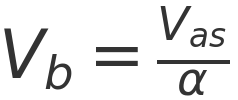Cabinet Volumes for Ported Speakers
When designing a speaker enclosure, especially a ported (bass reflex) box, it’s a common misconception that there’s one perfect cabinet volume for every driver. In reality, there’s a range of suitable volumes, each delivering a slightly different result depending on the design goal. Cabinet volume has a direct effect on bass response — not just in terms of depth, but in how the bass feels: tight and punchy vs deep and smooth.
The internal volume of the box interacts with the driver’s compliance (represented by Vas) and contributes to how freely the cone can move. A very large enclosure provides less air resistance (acoustic spring), allowing the cone to move more easily, which can improve low-end extension but may reduce control. Conversely, a smaller enclosure increases acoustic stiffness, restricting cone movement — which can tighten response but raise the system’s resonance.
It’s worth noting that modest changes in box volume aren’t inherently problematic. There’s no need to obsess over a perfect number — cabinet volume isn’t a razor-sharp target, but more of a zone you want to stay within. Problems tend to occur only when the volume is way off — such as using a box far too small or unnecessarily large for the driver. In practice, modern speaker designs aim for the smallest box possible that still delivers strong bass extension, reflecting a shift toward compact but efficient systems.
There’s always a trade-off between bass extension (how low it goes) and bass response (how tight or efficient it sounds). With that in mind, here’s a quick and practical method to estimate your starting box volume for a ported speaker:

- Vb: Recommended internal cabinet volume (in litres)
- Vas: Equivalent compliance volume of the driver (litres)
- α: Alignment factor, typically between 1.5 and 3
What Does Alpha Mean?
The value of α (alpha) determines how large or small your cabinet will be, and how the bass response is shaped the value of α in the formula above is a scaling factor that reflects how the compliance of the air inside the box compares to the compliance of the driver’s suspension (Vas). The speaker cone and the air inside the cabinet form a mass-spring system, and the box volume determines how stiff the air spring is.
- α ≈ 1.5 – A softer air spring, leading to a larger box. The cone moves more freely, resulting in better low-frequency extension. It’s close to a maximally flat alignment (like QB3 or SBB4), but physically bigger than most other options.
- α ≈ 3 – A stiffer air spring, giving a smaller box. This restricts cone movement more, often creating a bass hump and a stronger punch in the upper bass, at the cost of earlier low-end roll-off. It’s closer to alignments like SC4 or EBS, often used for compact or punchy systems. It’s closer to alignments like SC4 or EBS, often used for compact or punchy systems.
Choosing your α value is about balancing size and performance. Lower values favour flat, extended bass; higher values prioritise compact design and punchy response. We recommend sticking between 1.5 and 3 for purposes of calculating ball park figures. Choosing α is essentially choosing your compromise: deep and flat but large vs compact and punchy, with less deep bass.
Example
Say your driver has:
- Vas = 100 L
- Qts = 0.35
This driver suits a range of box volumes depending on your design goals:
- Flatter, deeper bass: Vb = 100 / 1.5 = 66.7 L
- Compact, punchy box: Vb = 100 / 3 = 33.3 L
So your practical range is between 33 to 67 litres — smaller if you prioritise space, larger if you want extended bass depth.
Please note, the above is a SIMPLIFIED calculator to estimate suitable cabinet sizes without getting too involved in the science. Here is the full formula:

This gives a more precise prediction based on Thiele-Small parameters and your chosen tuning frequency. Let’s break down what each part means:
- Vb: Recommended internal box volume (litres)
- Vas: Equivalent compliance volume of the driver (litres)
- Qts: Total Q of the driver (combined electrical and mechanical losses)
- fb: Desired box tuning frequency (Hz)
- fs: Driver’s free-air resonance frequency (Hz)
What It Tells You
- Higher Qts values usually call for a larger enclosure
- Lower tuning frequencies (fb) increase the required volume
This formula is useful as a starting point for simulation tools. It’s more accurate than the simplified Vas/α method, but assumes a traditional alignment without DSP-based adjustments to compensate for bass response. It also allows you to specify your target tuning frequency. You should also note that Qts is quite significant in determining suitability for bass reflex enclosures. The useable range for Qts is typically 0.28 – 0.45 with a ‘sweet spot’ at 0.37-0.38 which tends to gives many of the best ‘all round general purpose’ woofers for ported enclosures. The above calculations will give you Vb results for Qts values outside of this range, but these will most likely result in poor performance, or give unrealistic volumes that are too large or too small.